How often do you find yourself questioning the frequency of your cat's nail trimming routine? It's not an overstatement to say that proper nail care is crucial for your furry friend's health and wellbeing. While a kitten might need weekly trims, an adult cat could go for two weeks or more, and your outdoor explorer might even need less frequent sessions. But how can you tell when it's time? Stay tuned as we dive into the nitty-gritty of cat nail care, spotting overgrown nails, and maintaining the perfect trim schedule.
Understanding Cat Nail Anatomy
Before you start trimming your cat's nails, it's crucial to understand the unique anatomy of a cat's nail. Unlike human nails, cat nails are retractable, which means they're kept sheathed within the paw unless needed for hunting, climbing, or self-defense.
The nail structure consists of three parts – the outer layer called the keratin, the quick which is a sensitive area filled with nerves, and the nail bed, the skin beneath the nail. It's important to avoid cutting into the quick as it can cause pain and bleeding.
The knowledge of cat nail anatomy isn't just for trimming purposes, it's also essential for identifying potential problems like nail bed infections and claw disorders. Nail bed infections often result in swelling, redness, and a painful nail bed. On the other hand, claw disorders may manifest as overgrown or deformed nails.
If you notice any abnormalities, don't try to treat them yourself. Instead, consult a vet. They're equipped to diagnose and treat these conditions properly. It's also worth noting that regular nail care can help prevent these issues – but that's a topic for another section. Remember, understanding your cat's nail structure is the first step to proper nail care.
Importance of Regular Nail Trimming
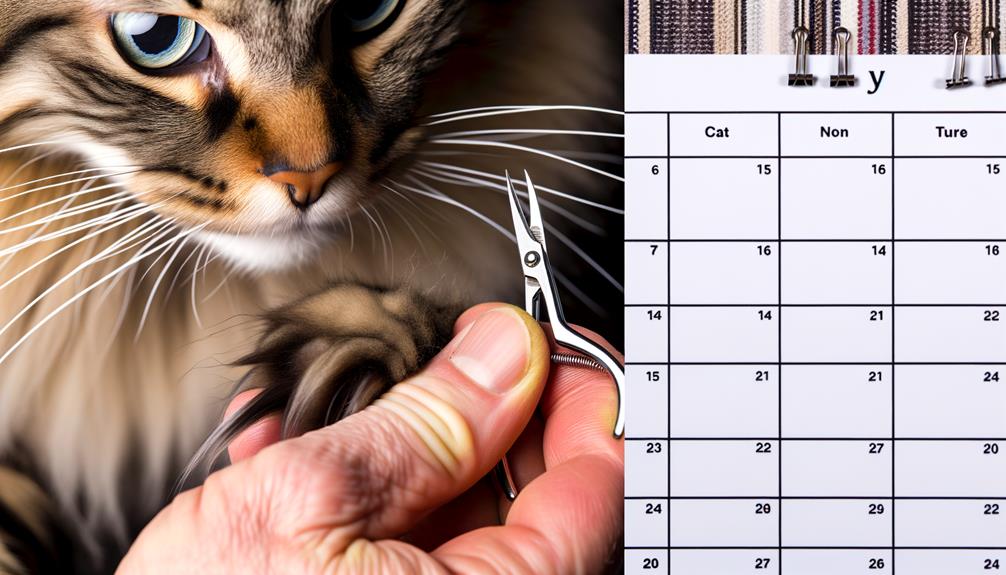
Keeping your cat's nails at an appropriate length through regular trimming isn't just about aesthetics, it's a vital part of their overall health and well-being. If you neglect this task, you're risking nail infections, which aren't only painful for your feline friend but can also lead to more serious health issues if left untreated.
Untrimmed nails can grow inwards, piercing the paw pad and causing infections. Also, when nails are too long, they're more likely to get stuck in things, causing distress and potential injury. You might notice behavioral changes, like your cat avoiding the litter box or showing reluctance to play, indicating discomfort due to long nails.
Moreover, regular nail trimming can prevent destructive scratching behavior. Cats with overgrown nails tend to scratch more to relieve the discomfort, which can result in damaged furniture or even injuries to humans. So, don't underestimate the importance of regular nail trimming. It's not just about keeping your home scratch-free, it's about ensuring the health, comfort, and happiness of your cat. Remember, a healthy cat is a happy cat, and happy cats make happy homes.
How to Spot Overgrown Cat Nails

Knowing when your cat's nails have become overgrown is crucial in maintaining their overall health and comfort. Overgrown nails can lead to various issues, including pain, difficulty in walking, and even nail infections. But how can you tell if your feline's nails are too long?
First, observe your cat's behavior. If they're limping, avoiding walking, or excessively licking their paws, these could be signs of discomfort due to overgrown nails. Next, take a close look at their claws. Overgrown nails typically curl around and dig into the paw pad.
The nail growth rate varies among cats, but a healthy cat's nails usually need trimming every 10 to 14 days. If it's been longer and the nails appear longer than usual, they might be overgrown.
Also, keep an eye out for nail infection signs. These include redness, swelling, pus, or even a foul smell from the paw. If your cat's claws appear discolored or brittle, it may also indicate an infection.
Frequency of Cat Nail Trimming
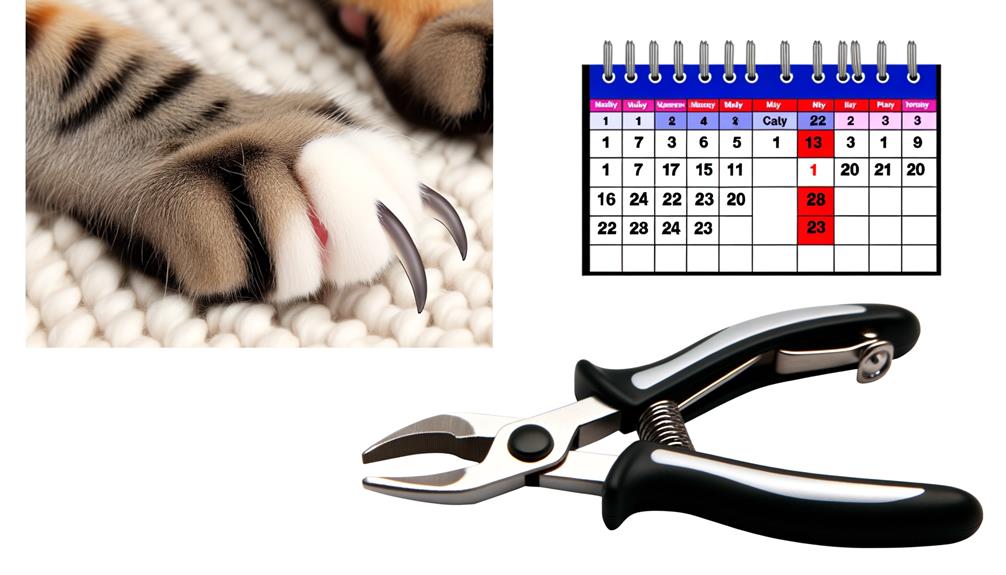
After spotting overgrown nails in your cat, your next step is to establish a regular trimming routine. But, how often should you take on this task? The answer isn't one-size-fits-all; trimming frequency variations depend on several factors, primarily your cat's age and lifestyle.
Kittens' nails grow quickly, so weekly trimmings are often necessary. As your cat matures, you can usually reduce this frequency. Adult indoor cats typically require a nail trim every two weeks, while outdoor cats may need less frequent trims, as their nails naturally wear down with outdoor activity.
The cat age influence on nail growth doesn't stop there. Seniors often have slower nail growth, so you might find a monthly trim is sufficient. However, keep in mind that aging cats may become less active, leading to less natural nail wear. Therefore, they may still require regular trims to prevent overgrowth and associated discomfort.
Step by Step Guide to Nail Trimming

Ready to tackle your cat's nails? Let's dive into a step-by-step guide for safe and effective trimming. The first thing you need to do is examine your cat's nail condition. Healthy nails are clear and smooth, while unhealthy ones may look discolored or feel rough.
Begin with the front claws. Hold your cat securely, but gently, in your lap. Extend one paw and press the pad to reveal the nails. Look for the translucent area of the nail, known as the quick. Avoid cutting into this as it can cause pain and bleeding.
Now, onto the trimming techniques. Hold the clippers perpendicular to the nail, not parallel. Start at the tip of the nail and make a quick, clean cut. Don't panic if you nick the quick; just apply some styptic powder to stop the bleeding.
Repeat this process with all front claws. For the back ones, you might find it easier if your cat is lying on its side. Remember, patience is key. If your cat becomes agitated, take a break and try again later. Lastly, always reward your cat after each session to associate nail trimming with positive experiences.
Tools Needed for Cat Nail Trimming
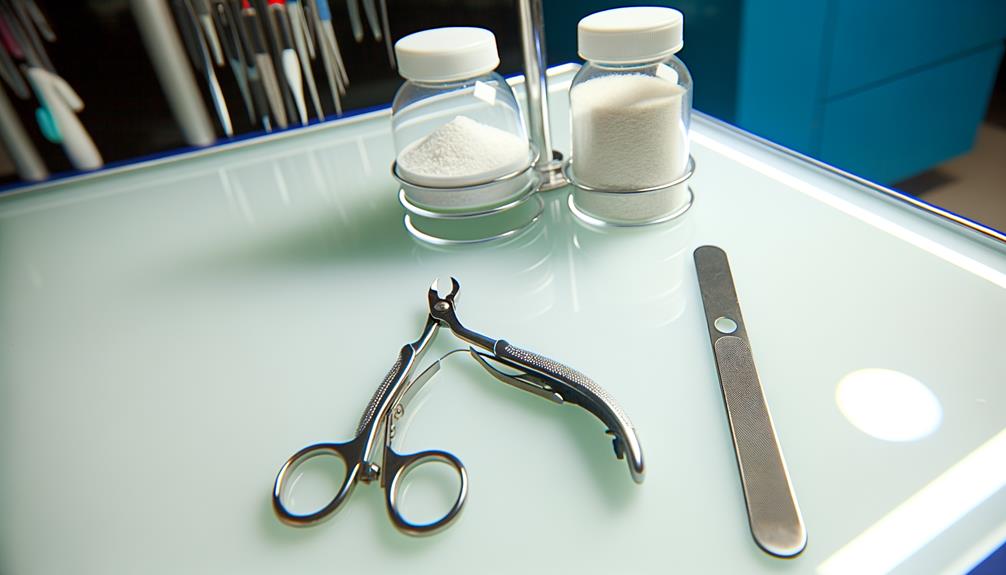
To trim your cat's nails effectively, you'll need the right tools. Nail clipper selection is crucial. You can't use your regular nail clipper. There are specialized clippers designed for pets, specifically cats. These clippers are shaped to fit a cat's small, curved nails and they come in different types – the guillotine type, the scissors type, and the grinder type. They're available at pet stores or online.
The guillotine type has a hole where you insert the nail and a blade that cuts it when you press the handle. The scissors type works like regular scissors but is smaller and has a curved edge to accommodate the cat's nails. The grinder type, though a bit more complex, gently grinds down the nail instead of cutting it.
But having the right nail clipper isn't enough. Trimming safety precautions are equally important. You'll need a styptic powder or pencil. Cats have a vein in their nails, known as the quick. If you cut into this, it can cause pain and bleeding. Styptic powder helps stop the bleeding if you accidentally cut the quick. Always have it on hand during trimming sessions.
Dealing With Cat Nail Trimming Anxiety

You may have noticed your cat showing signs of anxiety when it's time for a nail trim.
It's important to understand this anxiety and find ways to alleviate the stress associated with the process.
In this section, we'll discuss how you can do just that.
Understanding Cat Nail Anxiety
Despite the importance of nail trimming, many cats experience a significant amount of anxiety during the process. It's crucial to understand this anxiety through cat behavior analysis.
Here's what you need to look out for:
- Feline anxiety signs: Cats often show their discomfort through body language. Look for flattened ears, dilated pupils, or a tucked tail.
- Behavior changes: If your cat is usually calm but becomes aggressive or skittish during nail trims, it's likely experiencing anxiety.
- Avoidance: Does your cat run or hide at the sight of the nail clippers? This is a clear sign of anxiety.
Recognizing these signs is the first step in making nail trims less stressful for your cat.
Alleviating Trimming Stress
After recognizing the signs of anxiety in your feline during nail trims, there are several strategies you can employ to help alleviate this stress. Trimming alternatives like nail caps can be a less stressful option. These cover the claws, preventing scratching damage without the need for trimming.
Relaxation techniques also play a significant role in reducing stress. You can create a calm environment by using pheromone sprays or by providing a comfortable space for your cat during the process. It's also essential to introduce nail trimming gradually, starting with one nail at a time.
Professional Cat Nail Trimming Services
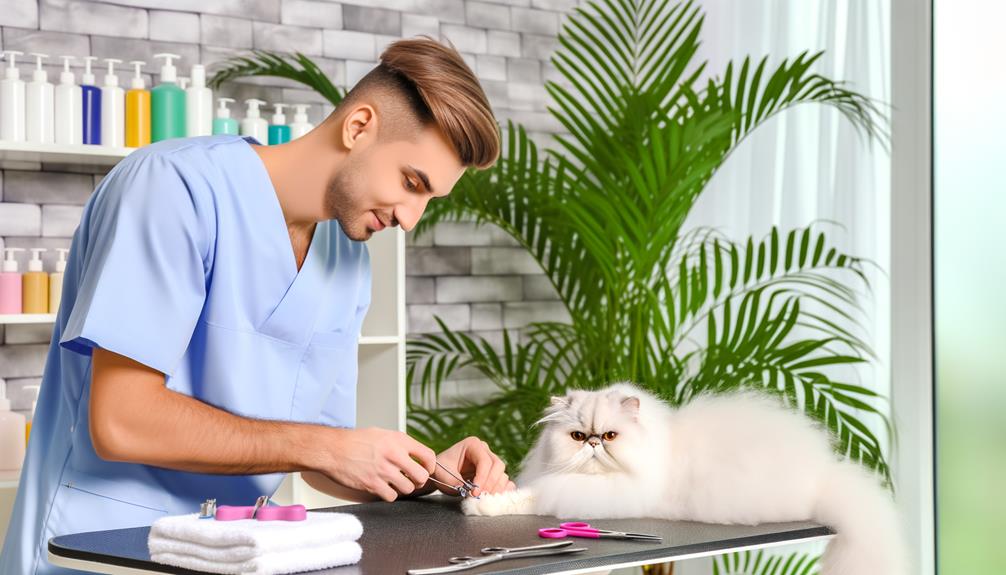
You might be considering professional cat nail trimming services for your feline friend.
Before you make a decision, it's important to understand the benefits of professional trimming, how to select the right service, and what the trimming process involves.
Let's start exploring these points to make the best choice for your cat's nail care.
Benefits of Professional Trimming
There's a wealth of benefits that come with opting for professional cat nail trimming services.
- Cost Efficiency: While you might initially balk at the trimming cost, remember quality services often save you more in the long run. Pros know how to do it right the first time, preventing potential health problems and future vet bills.
- Convenient Locations: Professional trimming locations are usually conveniently situated. Whether it's your local vet or a pet spa, you can easily drop off your cat and run errands while they're being pampered.
- Expertise: Professionals know exactly how far back to trim without causing discomfort or injury. This expertise means a stress-free experience for both you and your feline friend.
Professional trimming – it's a win-win for everyone.
Selecting a Nail Service
When it comes to choosing a professional cat nail trimming service, it's essential to consider factors such as their expertise, cost, and location. Nail service costs can vary greatly from one provider to another, so it's crucial to compare prices and ensure you're getting the best value for your money. But don't just go for the cheapest option – remember that your cat's comfort and safety should be your top priority.
Choosing a service provider requires some research. Look for a provider with a proven track record and positive customer reviews. Make sure they've trained professionals who understand cat behavior and nail structure. Lastly, consider their location. A closer provider can save you time and stress, especially if your cat dislikes travel. Make your choice wisely, taking all these factors into account.
Understanding the Trimming Process
Ever wondered what happens during a professional cat nail trimming session? Let's explore the process to understand how it contributes to your feline's nail health.
- Assessment: The professional first examines your cat's nails to identify any issues. They look for signs of overgrowth, splitting, or infection.
- Trimming techniques: Using specialized tools, the expert carefully trims each nail. They're trained to cut at the right angle and length, avoiding the quick to prevent pain or bleeding.
- Post-trim inspection: After trimming, another check ensures no nail is overlooked.
Risks of Neglecting Cat Nail Care
Ignoring your cat's nail care can lead to several health and safety issues. From infection prevention to behavioral implications, taking a lax approach to this critical aspect of pet care can have serious consequences.
Long, unkempt nails are prone to breaking or splitting, which can cause painful injuries and potentially lead to infections. This risk is heightened if your cat is an outdoor adventurer, where exposure to dirt and bacteria is inevitable. Even indoor cats aren't exempt, as litter box use can introduce harmful bacteria to any existing minor nail injuries.
Neglecting nail care can also have behavioral implications. Overgrown nails can cause discomfort, leading to changes in your cat's behavior. They might become more reclusive or display increased aggression due to the constant pain. Moreover, they may resort to inappropriate scratching behaviors, like tearing up furniture or carpets, as an attempt to naturally shorten their nails.
Health Benefits of Regular Nail Trimming
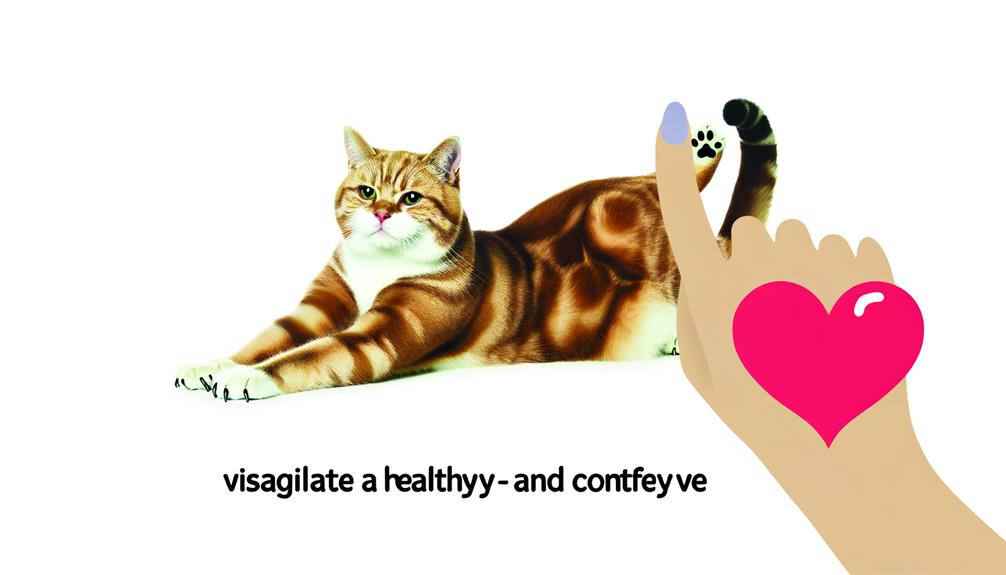
In contrast to the risks associated with neglecting your cat's nail care, regularly trimming your cat's nails offers a multitude of health benefits. It's not just about aesthetics or avoiding scratches on your furniture, it's about promoting optimum health for your feline friend.
The top three benefits of maintaining your cat's nail hygiene are:
- Nail Infections Prevention: Overgrown nails can lead to painful infections. Regular trimming prevents this by keeping the nails at a healthy length.
- Enhanced Mobility Benefits: Long nails can cause discomfort and affect your cat's natural walking and running behavior, potentially leading to joint problems. Regular trims ensure they can move around comfortably.
- Prevents Injuries: Overgrown nails can curl and grow into your cat's paw pad, causing painful injuries. Regular trimming avoids this issue.
When you make nail trimming part of your cat's grooming routine, you're not just maintaining your cat's physical appearance, but also enhancing its overall health and quality of life. Remember, nail care is a critical component of your cat's health regimen. So, don't forget to include it in your routine. Your cat will thank you!
Frequently Asked Questions
What to Do if I Accidentally Cut the Cats Nail Too Short?
If you've cut your cat's nail too short, don't panic. Apply a styptic powder to stop the bleeding. Prevent accidents by using proper tools and learning the correct trimming technique. Visit a vet if bleeding continues.
Can I Use Human Nail Clippers on My Cat?
Sure, you can use human clippers on your cat, but it's not ideal. Cat clippers are better suited for their small, curved nails. Proper clipping techniques are crucial to avoid hurting them or cutting too short.
How Can I Soothe My Cats Nails After Trimming?
You can soothe your cat's nails after trimming using nail conditioning techniques. Apply a gentle pet-safe moisturizer or balm to provide post trimming comfort. It'll help soothe any tenderness from the trimming process.
Are There Any Recommended Home Remedies for Overgrown Cat Nails?
For overgrown cat nails, DIY nail softeners and herbal remedies are beneficial. You can make a softener with olive oil and aloe vera. Alternatively, try chamomile or calendula, known for their healing properties.
What Are the Signs of Infection After Cat Nail Trimming?
You'll spot signs of infection after cat nail trimming like swelling, redness or pus. Using proper trimming techniques helps in infection prevention. If you're unsure, it's always best to consult with a vet.
Conclusion
In conclusion, it's crucial to keep your cat's nails trimmed regularly. The frequency depends on their age, lifestyle, and environment. Not only does it prevent health issues, but it also helps avoid behavioral problems.
If nail trimming is causing anxiety, seek professional help or use gentle methods. Remember, neglecting nail care can lead to severe consequences. So, make nail trimming a part of your cat's grooming routine for their overall well-being.







